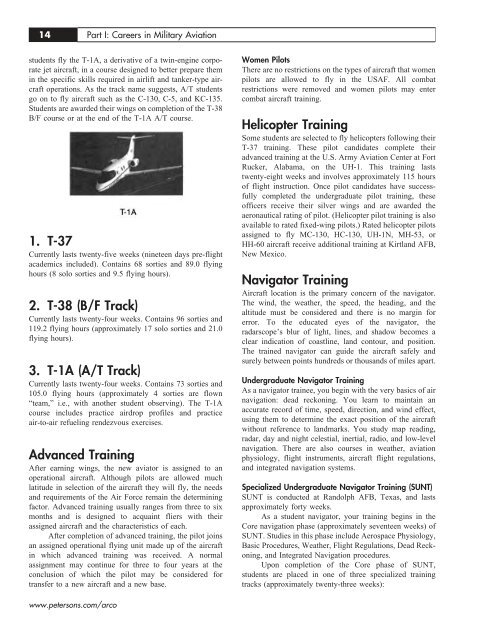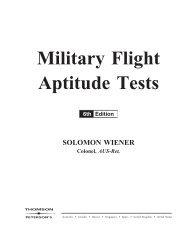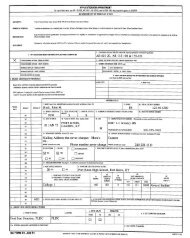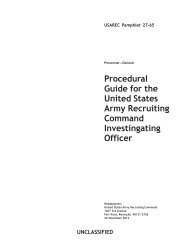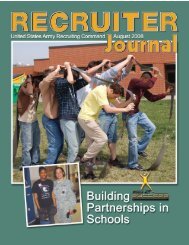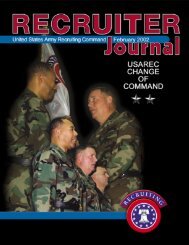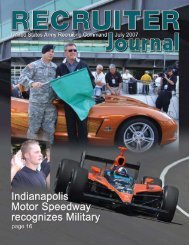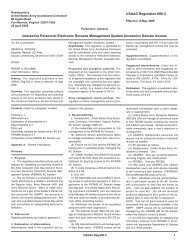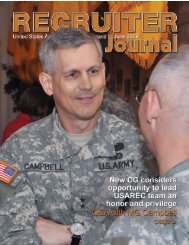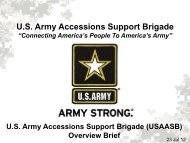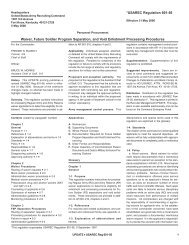Military Flight Aptitude Tests - USAREC - U.S. Army
Military Flight Aptitude Tests - USAREC - U.S. Army
Military Flight Aptitude Tests - USAREC - U.S. Army
Create successful ePaper yourself
Turn your PDF publications into a flip-book with our unique Google optimized e-Paper software.
14 Part I: Careers in <strong>Military</strong> Aviation<br />
students fly the T-1A, a derivative of a twin-engine corporate<br />
jet aircraft, in a course designed to better prepare them<br />
in the specific skills required in airlift and tanker-type aircraft<br />
operations. As the track name suggests, A/T students<br />
go on to fly aircraft such as the C-130, C-5, and KC-135.<br />
Students are awarded their wings on completion of the T-38<br />
B/F course or at the end of the T-1A A/T course.<br />
1. T-37<br />
Currently lasts twenty-five weeks (nineteen days pre-flight<br />
academics included). Contains 68 sorties and 89.0 flying<br />
hours (8 solo sorties and 9.5 flying hours).<br />
2. T-38 (B/F Track)<br />
Currently lasts twenty-four weeks. Contains 96 sorties and<br />
119.2 flying hours (approximately 17 solo sorties and 21.0<br />
flying hours).<br />
3. T-1A (A/T Track)<br />
Currently lasts twenty-four weeks. Contains 73 sorties and<br />
105.0 flying hours (approximately 4 sorties are flown<br />
“team,” i.e., with another student observing). The T-1A<br />
course includes practice airdrop profiles and practice<br />
air-to-air refueling rendezvous exercises.<br />
Advanced Training<br />
After earning wings, the new aviator is assigned to an<br />
operational aircraft. Although pilots are allowed much<br />
latitude in selection of the aircraft they will fly, the needs<br />
and requirements of the Air Force remain the determining<br />
factor. Advanced training usually ranges from three to six<br />
months and is designed to acquaint fliers with their<br />
assigned aircraft and the characteristics of each.<br />
After completion of advanced training, the pilot joins<br />
an assigned operational flying unit made up of the aircraft<br />
in which advanced training was received. A normal<br />
assignment may continue for three to four years at the<br />
conclusion of which the pilot may be considered for<br />
transfer to a new aircraft and a new base.<br />
www.petersons.com/arco<br />
Women Pilots<br />
There are no restrictions on the types of aircraft that women<br />
pilots are allowed to fly in the USAF. All combat<br />
restrictions were removed and women pilots may enter<br />
combat aircraft training.<br />
Helicopter Training<br />
Some students are selected to fly helicopters following their<br />
T-37 training. These pilot candidates complete their<br />
advanced training at the U.S. <strong>Army</strong> Aviation Center at Fort<br />
Rucker, Alabama, on the UH-1. This training lasts<br />
twenty-eight weeks and involves approximately 115 hours<br />
of flight instruction. Once pilot candidates have successfully<br />
completed the undergraduate pilot training, these<br />
officers receive their silver wings and are awarded the<br />
aeronautical rating of pilot. (Helicopter pilot training is also<br />
available to rated fixed-wing pilots.) Rated helicopter pilots<br />
assigned to fly MC-130, HC-130, UH-1N, MH-53, or<br />
HH-60 aircraft receive additional training at Kirtland AFB,<br />
New Mexico.<br />
Navigator Training<br />
Aircraft location is the primary concern of the navigator.<br />
The wind, the weather, the speed, the heading, and the<br />
altitude must be considered and there is no margin for<br />
error. To the educated eyes of the navigator, the<br />
radarscope’s blur of light, lines, and shadow becomes a<br />
clear indication of coastline, land contour, and position.<br />
The trained navigator can guide the aircraft safely and<br />
surely between points hundreds or thousands of miles apart.<br />
Undergraduate Navigator Training<br />
As a navigator trainee, you begin with the very basics of air<br />
navigation: dead reckoning. You learn to maintain an<br />
accurate record of time, speed, direction, and wind effect,<br />
using them to determine the exact position of the aircraft<br />
without reference to landmarks. You study map reading,<br />
radar, day and night celestial, inertial, radio, and low-level<br />
navigation. There are also courses in weather, aviation<br />
physiology, flight instruments, aircraft flight regulations,<br />
and integrated navigation systems.<br />
Specialized Undergraduate Navigator Training (SUNT)<br />
SUNT is conducted at Randolph AFB, Texas, and lasts<br />
approximately forty weeks.<br />
As a student navigator, your training begins in the<br />
Core navigation phase (approximately seventeen weeks) of<br />
SUNT. Studies in this phase include Aerospace Physiology,<br />
Basic Procedures, Weather, <strong>Flight</strong> Regulations, Dead Reckoning,<br />
and Integrated Navigation procedures.<br />
Upon completion of the Core phase of SUNT,<br />
students are placed in one of three specialized training<br />
tracks (approximately twenty-three weeks):


